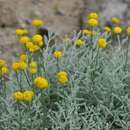en
names in breadcrumbs


Santolina is a genus of plants in the chamomile tribe within the sunflower family, primarily from the western Mediterranean region.[2][3]
They are small evergreen shrubs growing 10–60 cm (4–24 in) tall. The leaves are simple and minute in some species, or pinnate, finely divided in other species, often densely silvery hairy, and usually aromatic. The composite flowerheads are yellow or white, produced in dense globose capitula 1–2 cm in diameter, on top of slender stems held 10–25 cm (4–10 in) above the foliage. There are no ray florets.[4]
Santolina species are used as food plants by the larvae of some Lepidoptera species including Bucculatrix santolinella (feeds exclusively on S. chamaecyparissus) and the Coleophora case-bearers C. albicella (recorded on S. chamaecyparissus), C. involucrella (feeds exclusively on Santolina spp) and C. santolinella (feeds exclusively on S. chamaecyparissus).
numerous species formerly regarded as members of Santolina but now judged better suited to other genera: Achillea Athanasia Anthemis Calea Cladanthus Helenium Isocarpha Lasiospermum Lonas Matricaria Oedera Porophyllum Salmea Tanacetum
Santolina is a genus of plants in the chamomile tribe within the sunflower family, primarily from the western Mediterranean region.
They are small evergreen shrubs growing 10–60 cm (4–24 in) tall. The leaves are simple and minute in some species, or pinnate, finely divided in other species, often densely silvery hairy, and usually aromatic. The composite flowerheads are yellow or white, produced in dense globose capitula 1–2 cm in diameter, on top of slender stems held 10–25 cm (4–10 in) above the foliage. There are no ray florets.
Santolina species are used as food plants by the larvae of some Lepidoptera species including Bucculatrix santolinella (feeds exclusively on S. chamaecyparissus) and the Coleophora case-bearers C. albicella (recorded on S. chamaecyparissus), C. involucrella (feeds exclusively on Santolina spp) and C. santolinella (feeds exclusively on S. chamaecyparissus).